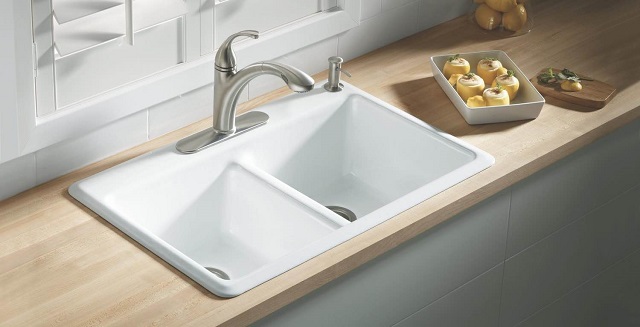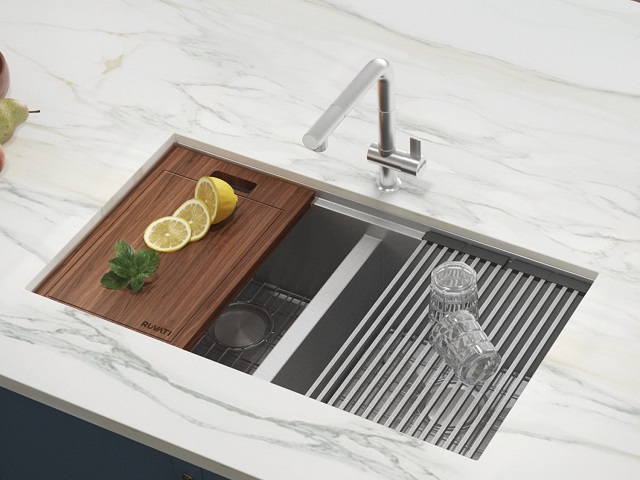One of the earliest lessons I learned as a designer came when I convinced a client to deviate from her desired kitchen sink idea because I thought it would look better in the space. Big mistake. I still practice what I learned from that rebuke to this day: very few people are ambivalent about the installation style, material or configuration of the kitchen sink that works for them. So here is a quick primer on kitchen sink that might help you if you are feeling unsure about what is important to you.
Mounting Styles
Self-Rimming or Drop-In Sinks

A drop in sink is the old-style option. A hole is cut into the countertop material and the sink hangs on counter, concealing the hole. It’s easy to install because the hole doesn’t have to be completely precise nor finished on the edge. The drawback is that the sink lip is usually too high for easy cleaning. Also, it doesn’t look as fashionable. Works best in traditional style settings.
Undermount Sinks

An undermount sink is just that – a sink that mounts under the countertop, exposing a cut out in the counter top with a finished edge. By far, the most popular style of sink mounting currently, given the popularity of both granite and quartz composite stone counters. It produces a cleaner, more custom look than a self-rimming style but cannot be used with all counter materials. Natural stones, quartz composites (engineered stones), and solid surface materials (like Corian) all work well with undermount sinks. Unlike those materials, an undermount just doesn’t work with laminate counters. Works well with both traditional and contemporary décor.
Farmhouse or Apron Sinks

Under the heading of ‘everything old is new again’. The apron front style harkens back to the days when each piece of kitchen equipment was independent of the others and most people lived on the farm. This is really a stylized undermount sink where the front (or apron) of the sink protrudes from the cabinet face. A very popular style at the moment and belying its name, this treatment works in both elegant and casual settings.
Common Materials
Stainless Steel

By far the most popular material for kitchen sinks. They are durable, low maintenance, stain resistant, and heat resistant. They clean up easily, and come in a multitude of mounting styles and configurations. The drawbacks are that they spot easily with hard water and they can scratch. Both are readily correctable.
Two things go into the final quality of a stainless steel sink: the thickness of the steel and the insulation that goes on the backside. Most stainless steel sinks on the market will be between 16 gauge and 22 gauge in thickness. It is counter-intuitive but in stainless steel, the smaller the number, the thicker the steel. You will find most sinks on the market currently come in either 16 or 18 gauge. The insulation does two things: reduces the reverberation of the metal and helps hold in the heat for a tub full of water. As for selections, personally, I’d rather see an 18 gauge sink with good insulation than a 16 gauge sink with poor insulation.
Cast Iron

Long a popular choice for kitchen sinks, the sinks are manufactured with a top layer of enameled porcelain over the iron. The glossy finish is relatively easy to maintain and is mostly durable. Complaints for cast iron sinks are that they can chip and heavy pots have a tendency to scuff the bottom of the sink. Scuff marks can be buffed out, chips can be patched.
Cast iron sinks can come in a multitude of colors, making them adaptable to almost every design taste. Because of their weight, some mounting styles might require additional support inside the cabinet.
Composite

Composite sinks are made up of granite stone dust and resins. This mixtures ensures the material is quite durable, resistant to heat, nonreactive, and long lived. Even so, they can still chip. Available only in matte finishes, the color palette can be limiting for some. And just like cast iron, its weight can require additional support for mounting.
Sink Configurations
Depending on how you prep for dinner, clean up after dinner, and what various auxiliary activities you perform in your kitchen sink will help determine the proper configuration for your lifestyle. The number of bowls in your sink, how multiple bowls are divided, and the depth of these sink bowls are the easiest ways to personalize your sink choice. Here are the most common options.
Single Bowl

One large bowl works well if you pile almost everything into your dishwasher on a regular basis. It also works well if your sink doubles as the dog’s bath. Giving maximum space to the task, the one complaint from clients is that the garbage disposal is not in a separate area, so a quick handwash while scraping dinner dishes might not be the most water-efficient task.
Equal Bowls

I think most of us grew up in a house with this sink configuration. Works well if you do a significant portion of your daily dishes by hand.
Big/Little Bowl

Similar to the previous but with an uneven split between bowls. A big/little bowl configuration gives you more space in the primary work bowl at the sacrifice of the secondary bowl’s size. Generally, the smaller bowl houses the garbage disposal, but there is no rule that requires it. These uneven splits can be found in everything from a 60/40 split, all the way to a 90/10 division, with stops in between.
Triple Bowl

Not the most common configuration because it requires additional space. Similar to an equal bowl sink, the small third bowl usually sits between the other two and contains the garbage disposal.
Galley

Gaining popularity, a galley sink can be one or two bowls, but the addition of a lip at the top holds various accessories, from a chopping block to a drain board. Originally designed for boats where space is at a premium, the chopping block then doubled as additional workspace, while covering up the sink area.
So which kitchen sink style is right for you? Let us know in the comments below.
